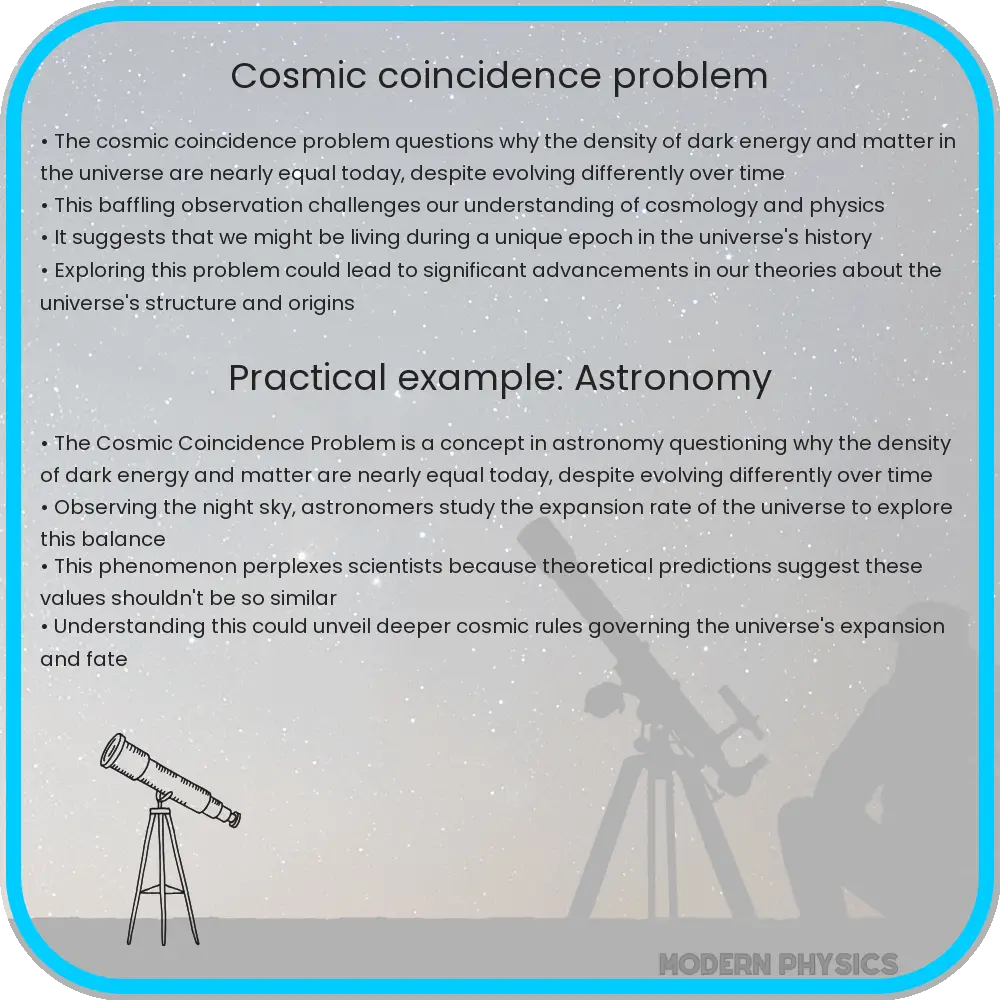Explore the Cosmic Coincidence Problem, its impact on cosmology, theories like quintessence, and the role of observational cosmology in understanding our universe.

The Cosmic Coincidence Problem in Cosmology
The Cosmic Coincidence Problem is a term used in modern cosmology that touches upon the curious timing and balance of forces in our universe. It specifically refers to the puzzling observation that the density of dark energy in the universe is of the same order of magnitude as the density of matter at the present epoch. This is surprising because these two quantities evolve differently over time, and their equivalence at this particular moment in the universe’s history seems remarkably coincidental.
Understanding Dark Energy and Matter
Before delving deeper into the Cosmic Coincidence Problem, it’s crucial to understand the components at play. The universe contains ‘dark energy,’ a mysterious force that is driving the accelerated expansion of the universe, and ‘dark matter,’ which, unlike ordinary matter, does not emit, absorb, or reflect light but exerts gravitational effects. Dark energy makes up about 68% of the universe, while dark matter constitutes about 27%, leaving only 5% for all ordinary matter.
The Fine-Tuning of the Universe
The term ‘fine-tuning’ in cosmology refers to the precise balance of cosmological constants and physical laws that allow the existence of life, galaxies, stars, and planets. If any of these constants were only slightly different, the universe would be drastically altered and potentially incapable of supporting life as we know it. The fine-tuning problem raises questions about why the constants of the universe are so precisely balanced.
Implications of the Coincidence
The Cosmic Coincidence Problem leads to several philosophical and scientific discussions. It challenges our understanding of the universe and prompts questions about the initial conditions of the Big Bang, the nature of dark energy, and the ultimate fate of the universe. Some theorists propose the anthropic principle, suggesting that the universe has the properties it does because otherwise, we would not be here to observe it. Others look towards the multiverse theory, which posits that our universe is just one of many, each with different physical laws and constants.
Exploring Solutions and Theories
Several theoretical solutions have been proposed to address the Cosmic Coincidence Problem. One approach is the concept of quintessence, a dynamic, evolving form of energy field that could explain why the densities of dark energy and matter are comparable at this epoch. Another idea involves modifications to the standard model of cosmology, introducing new forms of energy or changing the properties of dark energy over time.
Impact on Future Research
The Cosmic Coincidence Problem has significant implications for future research in cosmology. It guides scientists in developing new theories and models that could explain the fine-tuned nature of the universe. Additionally, it motivates ongoing observations and experiments aimed at understanding dark energy, dark matter, and the fundamental laws governing the cosmos. The resolution of this problem could lead to groundbreaking discoveries in physics and cosmology, potentially revealing new aspects of the universe’s history and structure.
The Role of Observational Cosmology
Observational cosmology plays a crucial role in addressing the Cosmic Coincidence Problem. By studying the cosmic microwave background, the distribution of galaxies, and the rate of the universe’s expansion, scientists can gather evidence that may explain why we observe such a coincidence today. Advances in technology and methodologies are continually enhancing our ability to observe and understand the universe, providing new insights into this perplexing issue.
Conclusion
The Cosmic Coincidence Problem remains one of the most intriguing puzzles in modern cosmology. It challenges our understanding of the universe and prompts deep questions about the nature of reality, the fundamental laws of physics, and the initial conditions of the cosmos. While various theories and models have been proposed, the problem is far from being resolved. Continued research and observations are essential to uncovering the underlying reasons behind this cosmic coincidence. As we delve deeper into the mysteries of the cosmos, we may come closer to understanding the true nature of the universe and our place within it.
